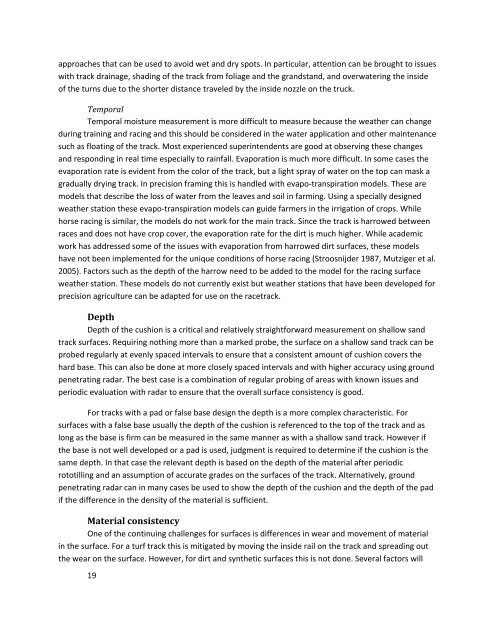Retired Racehorses
tfrr_reportandappendicesfinal
tfrr_reportandappendicesfinal
- No tags were found...
You also want an ePaper? Increase the reach of your titles
YUMPU automatically turns print PDFs into web optimized ePapers that Google loves.
approaches that can be used to avoid wet and dry spots. In particular, attention can be brought to issues<br />
with track drainage, shading of the track from foliage and the grandstand, and overwatering the inside<br />
of the turns due to the shorter distance traveled by the inside nozzle on the truck.<br />
Temporal<br />
Temporal moisture measurement is more difficult to measure because the weather can change<br />
during training and racing and this should be considered in the water application and other maintenance<br />
such as floating of the track. Most experienced superintendents are good at observing these changes<br />
and responding in real time especially to rainfall. Evaporation is much more difficult. In some cases the<br />
evaporation rate is evident from the color of the track, but a light spray of water on the top can mask a<br />
gradually drying track. In precision framing this is handled with evapo‐transpiration models. These are<br />
models that describe the loss of water from the leaves and soil in farming. Using a specially designed<br />
weather station these evapo‐transpiration models can guide farmers in the irrigation of crops. While<br />
horse racing is similar, the models do not work for the main track. Since the track is harrowed between<br />
races and does not have crop cover, the evaporation rate for the dirt is much higher. While academic<br />
work has addressed some of the issues with evaporation from harrowed dirt surfaces, these models<br />
have not been implemented for the unique conditions of horse racing (Stroosnijder 1987, Mutziger et al.<br />
2005). Factors such as the depth of the harrow need to be added to the model for the racing surface<br />
weather station. These models do not currently exist but weather stations that have been developed for<br />
precision agriculture can be adapted for use on the racetrack.<br />
Depth<br />
Depth of the cushion is a critical and relatively straightforward measurement on shallow sand<br />
track surfaces. Requiring nothing more than a marked probe, the surface on a shallow sand track can be<br />
probed regularly at evenly spaced intervals to ensure that a consistent amount of cushion covers the<br />
hard base. This can also be done at more closely spaced intervals and with higher accuracy using ground<br />
penetrating radar. The best case is a combination of regular probing of areas with known issues and<br />
periodic evaluation with radar to ensure that the overall surface consistency is good.<br />
For tracks with a pad or false base design the depth is a more complex characteristic. For<br />
surfaces with a false base usually the depth of the cushion is referenced to the top of the track and as<br />
long as the base is firm can be measured in the same manner as with a shallow sand track. However if<br />
the base is not well developed or a pad is used, judgment is required to determine if the cushion is the<br />
same depth. In that case the relevant depth is based on the depth of the material after periodic<br />
rototilling and an assumption of accurate grades on the surfaces of the track. Alternatively, ground<br />
penetrating radar can in many cases be used to show the depth of the cushion and the depth of the pad<br />
if the difference in the density of the material is sufficient.<br />
Material consistency<br />
One of the continuing challenges for surfaces is differences in wear and movement of material<br />
in the surface. For a turf track this is mitigated by moving the inside rail on the track and spreading out<br />
the wear on the surface. However, for dirt and synthetic surfaces this is not done. Several factors will<br />
19


